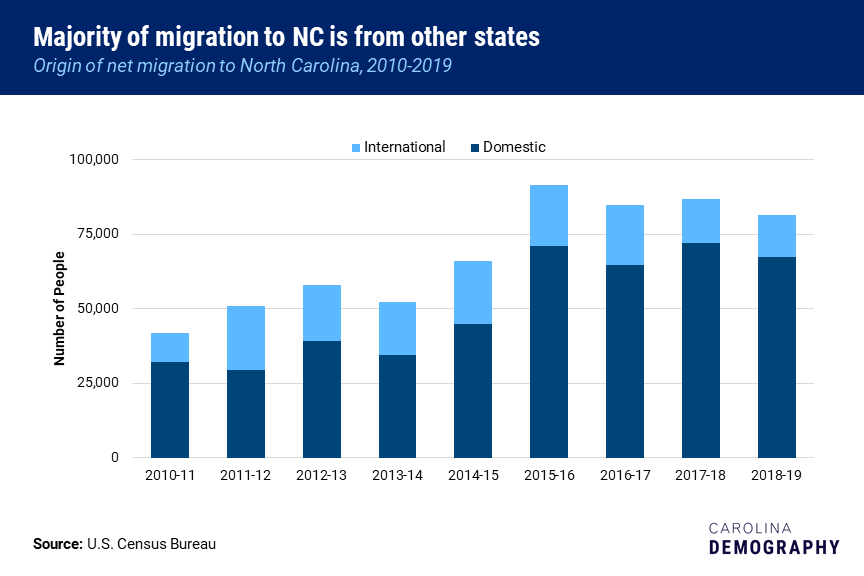North Carolina on track to surpass 10.6 million by 2020, gain in the House

North Carolina’s population grew to an estimated 10.5 million people as of July 1, 2019, according to new estimates from the U.S. Census Bureau.
From July 1, 2018 to July 1, 2019, the state’s population increased by nearly 106,500 individuals. This marks the fourth year in a row that North Carolina has grown by more than 100,000 new residents. Among the states, North Carolina had the 4th largest numeric increase since 2018. Only Texas (367K), Florida (233K), and Arizona (121K) gained more residents over the past year.
With a growth rate of 1.0% since 2018, North Carolina grew twice as fast as the national average (0.5%) and was the 10th fastest-growing state. Apart from Texas (#5), the top five fastest-growing states in the last year were all Western states:
While North Carolina has maintained steady growth since 2010, population losses are increasingly common in other states. Ten states experienced population losses between 2018 and 2019. New York (-77K) and Illinois (-51K) had the largest estimated losses, followed by West Virginia (-12K), Louisiana (-11K), and Connecticut (-6K). West Virginia lost the largest percentage of its population (-0.7%), followed by Alaska (-0.5%) and Illinois (-0.4%). 2019 also marked the first time this decade that the Northeast region—as a whole—lost population, declining by nearly 64,000 or -0.1%.
Since the 2010 Census, North Carolina’s population has grown by 952,000 residents, an increase of 10%. Two-thirds or 67% of this growth was due to net in-migration, meaning more individuals moving to North Carolina than moving away. The share of state growth from net migration is increasing as growth from natural increase (births minus deaths) steadily declines due to lower fertility and more deaths from population aging.

In the most recent year, North Carolina received an estimated 81,500 net in-migrants (77% of total population growth). This was the 4th largest net in-migration of any state; only Florida (223K), Texas (191K), and Arizona (99K) had more growth from net migration last year.
Most of these in-migrants were domestic migrants (67K), meaning that they moved to North Carolina from other states. According to detailed data in the 2018 American Community Survey (ACS), North Carolina had the largest net in-migration from New York (15K), Florida (13K), New Jersey (5.5K), Virginia (5.4K), and Pennsylvania (5.1K).
The state receives relatively fewer international migrants, a group that includes both immigrants and citizens returning to the U.S. from abroad, such as returning military personnel. Between 2018 and 2019, North Carolina received just over 14,000 net in-migrants from other countries. The largest in-flows were from Japan, India, and Mexico, according to the 2018 ACS.

These new estimates are consistent with the latest population projections from the State Demographer that project North Carolina will have more than 10.6 million residents by 2020.
According to projections based on the 2019 population estimates, North Carolina remains on track to pick up a 14th seat in the U.S. House of Representatives, provided current population trends continue. North Carolina is one of seven states projected to gain representation in the House: Texas is projected to gain 3 seats, Florida is projected to gain 2, and Arizona, Colorado, Montana, North Carolina, and Oregon are each projected to gain one.
Ten states are projected to lose a seat in the House. While these states are clustered in the Northeast (New York, Pennsylvania, Rhode Island) and Midwest (Illinois, Michigan, Minnesota, Ohio), Southern (Alabama and West Virginia) and Western (California) states are also predicted to lose a seat.
Need help understanding population change and its impacts on your community or business? Carolina Demography offers demographic research tailored to your needs.
Contact us today for a free initial consultation.
Contact UsCategories: Carolina Demographics, Census 2020, Migration, NC in Focus

The Center for Women’s Health Research (CWHR) at the University of North Carolina School of Medicine released the 12th edition of our North Carolina Women’s Health Report Card on May 9, 2022. This document is a progress report on the…

Dr. Krista Perreira is a health economist who studies disparities in health, education, and economic well-being. In collaboration with the Urban Institute, she recently co-led a study funded by the Kate B. Reynolds Foundation to study barriers to access to…

Our material helped the NC Local News Lab Fund better understand and then prioritize their funding to better serve existing and future grant recipients in North Carolina. The North Carolina Local News Lab Fund was established in 2017 to strengthen…
Your support is critical to our mission of measuring, understanding, and predicting population change and its impact. Donate to Carolina Demography today.